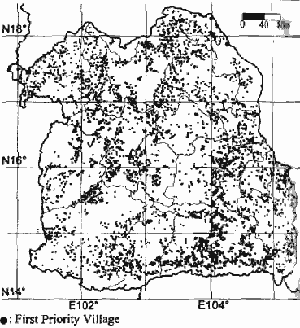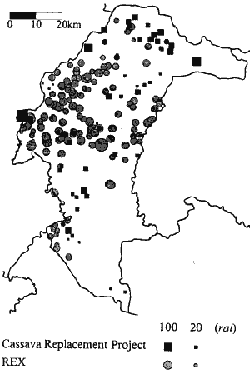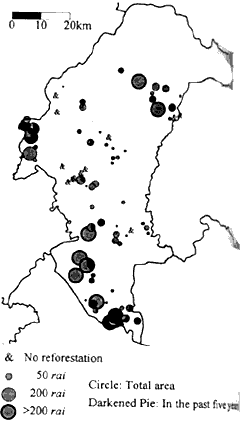| GISdevelopment.net ---> AARS ---> ACRS 1996 ---> Forestry / Vegetation |
Application of NETVIS to the
Evaluation of a Reforestation Project in Northeast Thailand
Nagata
Yoshikatsu1, Yoshida Kengo2, Takeda
Shinya3 and Kono
Yasuyuki4
1Media Center, Osaka City University
3-138, Sugimoto 3, Sumiyoshi; Osaka 558, Japan
Tel & Fax: +81-6-605-3380
Email : nagata@media.osaka-cu.ac.jp
2Reforestation and Extension Project in the Northeast of Thailand (JIOA-REX)
P.O. Box 81, Khon Kaen 40000, Thailand
Tel & Fax : +66-1-954-2939
3Faculty of Agriculture, Kyoto University
Oiwake-cho, Kita-shirakawa, Sakyo, Kyoto 606-01, JAPAN
Tel : +81-75-753-6376 Fax: +81-75-753-6372
Email : takedas@kais.kais.kyoto-u.ac.jp
4Center for Southeast Asian Studies, Kyoto University
46 Shimo-adachi-cho, Yoshida, Sakyo, Kyoto 606-01, JAPAN
Tel: +81-75-753-7324 Fax: +81-75-753-7350
Email: kono@cseas.kyoto-u.ac.jp.
Abstract1Media Center, Osaka City University
3-138, Sugimoto 3, Sumiyoshi; Osaka 558, Japan
Tel & Fax: +81-6-605-3380
Email : nagata@media.osaka-cu.ac.jp
2Reforestation and Extension Project in the Northeast of Thailand (JIOA-REX)
P.O. Box 81, Khon Kaen 40000, Thailand
Tel & Fax : +66-1-954-2939
3Faculty of Agriculture, Kyoto University
Oiwake-cho, Kita-shirakawa, Sakyo, Kyoto 606-01, JAPAN
Tel : +81-75-753-6376 Fax: +81-75-753-6372
Email : takedas@kais.kais.kyoto-u.ac.jp
4Center for Southeast Asian Studies, Kyoto University
46 Shimo-adachi-cho, Yoshida, Sakyo, Kyoto 606-01, JAPAN
Tel: +81-75-753-7324 Fax: +81-75-753-7350
Email: kono@cseas.kyoto-u.ac.jp.
The authors have been developing the Northeast Thailand Village Information System (NETVIS), a GIS application in which village-level agricultural and socio-economic conditions are integrated. The present study aims to apply NETVIS to the evaluation of a JICA-supported reforestation project. This project started in 1992, and during the last four years it has distributed more than fifty million seedlings of various tree species to farmers in addition to providing training courses and extension services . Monitoring works on distributed seedlings were, however, not carried out, and the increase in the reforested area is not known. By inputting the results of a questionnaire survey administered to village headmen on recent reforestation and available revealed. Further investigation is now going on and will indicate spatial differences in these use of distributed seedling and its relationship with available land resource and farmers' job structure. This implies the effectiveness of NETVIS not only for project evaluation but also on project set-up including selection of target areas. This is an interim report of our trial.
1. Background
Thailand lost an area of forest equivalent to about one-quarter of its total area in 30 years from 1961. In the same period, the decrease in forest area in Northeast Thailand, which accounts for one-third of the area of the kingdom, is about 30% of the region (RFD, 1985). To prevent further loss of forest, many reforestation projects are in progress, Besides those run by the Royal Forest Department (RFD), other government organizations such as the Community Development Department (CDD), the Department of Agricultural Extension (DOAE) and the Forestry Industry Organization (FIO) and NGOs typified by the Population and community Development Association (PDA) have their own projects (Akaha, 1994).
One of these projects, the Reforestation and Extension and Extension Project in the Northeast of Thailand (REX), in which the authors are involved, has entered its final year. In this report, we introduce a case study of application of NETVIS to the evaluation of REX. Further details about NETVIS appear in earlier papers (Nagata, 1996a; 1996b).
2. Reforestation Projects in Northeast Thailand
2.1 REX
This five-year project was started in April 1992 by RFD and the Japan International Cooperation Agency (JICA). RFD documents state that related programs began in the Thai fiscal year 1991. Its objective is to promote reforestation by villagers across the whole of Northeast Thailand. At first, it listed up about 5,900 target villages as first priority areas based on the criterion of shortage of fuel wood (Figure 1). The total about 10% of all villages in the Northeast (REX, 1994).

Figure 1 First Priority Villages of REX
Core activities of REX are seedling production and distribution, extension, training, and demonstration plantations. For production and distribution of seedlings, four nursery centers were established (Figure 2), which produce the seedlings according to the villagers' demand. About half of the seedlings produced are varieties of eucalyptus, reflecting the recent increase in market demand for eucalyptus wood, and the other half includes many kinds of species like teak and fruit trees.

Figure 2 Nursery Centers and Questionnaired Provinces
2.2 Other Projects Operated by RFD
Other RFD-operated projects related to the reforestation of private and public village land are briefly mentioned.
(1) Farmers Forest Plantation Extension Project
Subsidies of 3000 baht (about 25 baht = US$1) per rai (1 rai = 0.16 ha) over five years are available for reforestation of species such as teak on private land. This started in 1994 and is expected to expand its area of operation by one million rai per year. This project excludes fast-growing species like eucalyptus.
(2) Cassava Replacement Project
This project started in 1994 to promote the replacement of cassava by fast-growing trees like eucalyptus, since when eligibility of subsidy has extended to abandoned rice fields. Its activities includes distribution of seedlings and chemical fertilizers, and provision of participants with low-interest loans.
(3) Community Forest Development Program
This program was introduced in 1987. Its purpose is to subsidize the establishment of community forest on public village land. Training and guidance in seedling production are among its activities. The major species planted is eucalyptus.
(4) Thung Kula Ronghai Development Project
Thung Kula Ronghai is a large lowland along Mae Nam Mun (River) in the southern part of the Northeast. This project aims to protect the area from salt pollution and flooding by planting useless land. It was initiated in 1982 and included in the seventh National Economic and Social Development Plan (1982-1996).
3. Trial Study on Project Evaluation
Since a reforestation project must extend over a long period of time, we should not expect remarkable results after a short period of five year. In the case of REX, moreover, on the activity of reforestation assist, the only channel between the project managers and villagers is in seedling distribution, after which matters are left in villagers' hand. It is inevitable that the project side tends to evaluate its results in terms of numbers of seedlings distributed, which are the only records readily available however, he project's goal is not seedling distribution but reforestation. A well-founded conjecture on the progress of reforestation might contribute to more effective operation of the project. Yet there are no statistics on reforestation of private land, in which REX is deeply concerned. So we planned to collect various material on reforestation and records concerning REX and other projects so that we can discuss reforestation with NETVIS-based geographical outputs. To know the latest situation with regard to reforestation in the villages, we also questionnaire village headmen.
3.1 Questionnaire
Many reforestation projects are in progress and many handle the same or similar species, like eucalyptus. It is thus natural that villagers often cannot remember the name of the project from which they received seedlings. Therefore, the prime object of the questionnaire was to grasp changes in the state of the forest of a village in the past five years regardless of the involvement of REX.
We decided on four provinces, Maha Sarakham, Nong Bua lamphu, Buriram and Yasothon, to be questionnaired, taking into consideration the existence of four nursery centers and processing capability. The questionnaire was distributed to every village headman (Figure 2). It covered : 1) eucalyptus forestation as a whole ; 2) eucalyptus forestation in the past five years. Each item had sub-items for a) public land; b) private and c) total. Headmen were questionnaired about 5,200 villages in total and about 20% of them replied.
3.2 Discussion
REX had operated in more than 1,500 village by the end of the 1995 fiscal year. Figure 3 shows how these villages correspond with those listed in the initial plan: about half were included in the initial list, and half were not. Further inspection of the data reveals that the project adhered to the listed villages in early years but gradually departed from the initial plan. Usually it is not easy to find suitable land for a knocked-down nursery near a listed village, and therefore much labor is required for preparation. One reason for the inadequacy of preparation might be that RFD had to share its capacity to produce seedlings between REX and another new project that began later.

Figure 3 Op[erated Target Villages of REX
Nevertheless, there are some areas, like Yasothon Province, where the project has been carried out according to plan. The following discussion will focus on the situation in Yasothon Province. Figure 4 shows the and the REX project. The area planted under the REX project. The area planted under of distributed seedlings at the conversion rate of 400 seedlings per rai, as eucalyptus is normally planted a 2-meter intervals. It is clear that the target village of the two projects do not overlap each other, and this indicates the need to investigate in more detail the differences between the target areas of each project.

Figure 4 Cassava Replacement Project and REX in Yasothon
Figure 5 shows the state of eucalyptus reforestation according to the questionnaire. It shows the total planted area of eucalyptus and the proportion planted in the past five years. The response to the questionnaire from Yasothon was 14% and unfortunately no replies were received from two districts, Kut Chum and Loeng Nok Tha, where the two projects are concentrated. Therefore, detailed investigation of the effect of the two projects is not easy, although some reforestation is evident from the available information.

Figure 5 Eucalyptus Reforestation in Yasothon
4. Conclusion
This is a preliminary report to present facts that are emerging through output from available data under he framework of NETVIS. The data obtained does not always allow further discussion, but it can be said that a GIS application will contribute to show important facts for evaluation of the project.
We planned this study in view of the fact that this is the final year of REX and collected many kinds of materials. Data collection did not always proceed favorably. It would have been more smooth and more complete if it had been clear at the initial stage of the project what data needed to be accumulated. In that the utilization of GIS is becoming increasingly popular, we would like to suggest that GIS application must be clearly incorporated in the initial plan of REX-like social project.
Acknowledgement
This study was support by REX. Cooperation in data collection was extended by the officers of four nursery extension centers of the Forest Nursery Division, Reforestation Office of RFD. We wish to express our gratitude to Mr. Murasawa Masaru, the project leader of the JICA-REX, for his understanding of our study. Thanks are also extended to Mr. Anan Son-ngai, the field manager, and four chiefs of nursery extension centers for their help with arrangements.
References
- Akaha, Takeshi, 1994. Study on Institutionalization of Collaborative Systems to Promote Social Forestry in Thailand (in Japanese). A study on the Development of a system for Identification, Registration and Utilization of Specialists in Education Required for International Co-operation Volume 2, pp. 127-248, Foundation for Advanced Studies on International Development (FASID), Tokyo.
- Nagata, Yoshikastu, 1996a. Mapping the Village Database: The Spread of Economic Growth to Rural Areas of Northeast Thailand. Southeast Asian Studies, 33(4), pp.138-158, Kyoto.
- Nagata Yoshikatsu, 1996b. Changes in Rural Areas of Northeast Thailand in the Latter Half of the 1980s as Seen Through the Northeast Thailand Village Information System. International Archives of Photobgrammetry and Remote Sensing, 31-B7, pp.516-521.
- Reforestation and Extension Project in the Northeast of Thailand (RES)
- Royal Forest Department (RFD), Thailand, 1985. Forestry Statistics of Thailand 1985
- Royal Forest Department (RFD), Thailand, 1994. Forestry Statistics of Thailand 1994.